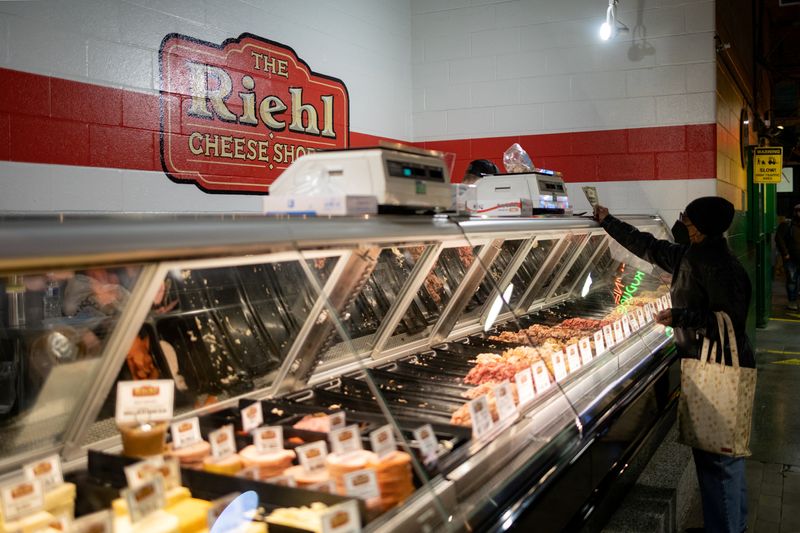By Lucia Mutikani
WASHINGTON (Reuters) - U.S. producer prices increased solidly in May as the cost of gasoline surged, another sign of stubbornly high inflation that could force the Federal Reserve to raise interest rates as much as 75 basis points on Wednesday.
The Labor Department report on Tuesday followed news last week that consumer prices accelerated in May, culminating in the largest year-on-year increase since 1981. Globally, inflation has surged since Russia invaded Ukraine in February, and the war has boosted oil and grain prices.
"Producer price increases continue to shoot higher which means even more pipeline pressures for the consumer in the months to come," said Christopher Rupkey, chief economist at FWDBONDS in New York. "This argues for a strong response from Fed officials to somehow get out in front of market expectations and tell the public they are winning the inflation fight."
The producer price index for final demand rose 0.8% last month after advancing 0.4% in April. A 1.4% jump in the prices of goods accounted for nearly two-thirds of the rise in the PPI. Goods prices, which rose 1.3% in April, were driven by soaring costs for energy products.
Wholesale gasoline prices rebounded 8.4% after falling 3.0% in April, making up 40% of the rise in the costs of goods. Jet fuel increased 12% after shooting up 14.8% in April. There were also increases in the cost of residential natural gas, steel mill products and diesel fuel.
Wholesale food prices were unchanged after increasing 1.4% in the prior month as the cost of beef and veal fell 9.5%, offsetting an increase in processed young chickens. Excluding food and energy, goods prices rose 0.7% after increasing 1.1% for two straight months.
In the 12 months through May, the PPI increased 10.8% after accelerating 10.9% in April. Last month's increase in the PPI was broadly in line with economists' expectations.
Stocks on Wall Street were lower. The dollar rose against a basket of currencies. U.S. Treasury prices fell, with the interest rate sensitive two-year note yield rising to the highest level since 2007.
INFLATION HOT
Government data last Friday showed a broad increase in consumer prices in May, which raised concerns inflation could become entrenched. Those fears were amplified by a University of Michigan survey last week showing consumers' five-year inflation expectations jumped in early June to a 14-year high of 3.3% from a final reading of 3.0% in May.
With inflation far exceeding the Fed's 2% target by all measures, risks are growing that the economy could stagante or fall into recession next year.
The U.S. central bank is expected to raise its policy interest rate on Wednesday for a third time this year, with an increase of 3/4 of a percentage point seen as likely, and possibly signals for more large hikes to come.
China's zero COVID-19 policy is dislocating supply chains, keeping goods prices high and adding to inflationary pressure. A shortage of workers is driving up wages, resulting in higher prices for services.
The cost of wholesale services rebounded 0.4% in May after declining 0.2% in April. A 2.9% rise in prices for transportation and warehousing accounted for more than half of the broad-based advance in services. Truck transportation of freight rose 2.9%.
Excluding the volatile food, energy and trade services components, producer prices rose 0.5% in May. The so-called core PPI gained 0.4% in April. In the 12 months through May, the core PPI increased 6.8% after rising by the same margin in April.
There were also increases in costs of services related
to securities brokerage and dealing, machinery and equipment wholesaling as well as chemicals and allied products, automobiles and parts retailing, and transportation of passengers.
But margins for fuels and lubricants retailing plunged 21.7%. Portfolio management fees dropped because of the stock market rout, and prices for hotels and motel rooms fell. The costs of doctor and hospital inpatient care rose modestly, while airline fares increased 2.9%.
These components go into the calculation of the core personal consumption expenditures (PCE) price index, one of the inflation measures closely watched by Fed officials.
With the PPI and CPI data in hand, economists are forecasting that the core PCE price index increased 0.4% in May after rising 0.3% for three straight months. In the 12 months through May, the core PCE price index is seen climbing 4.7% after advancing 4.9% in April.

"We would not expect the Fed to take much comfort in a softer trend of core PCE that is a result of weaker medical services related to Medicare payments and falling asset prices," said Veronica Clark, an economist at Citigroup (NYSE:C) in New York.
"It will be some time before inflation slows enough for the Fed to feel more comfortable shifting from a very hawkish policy stance."